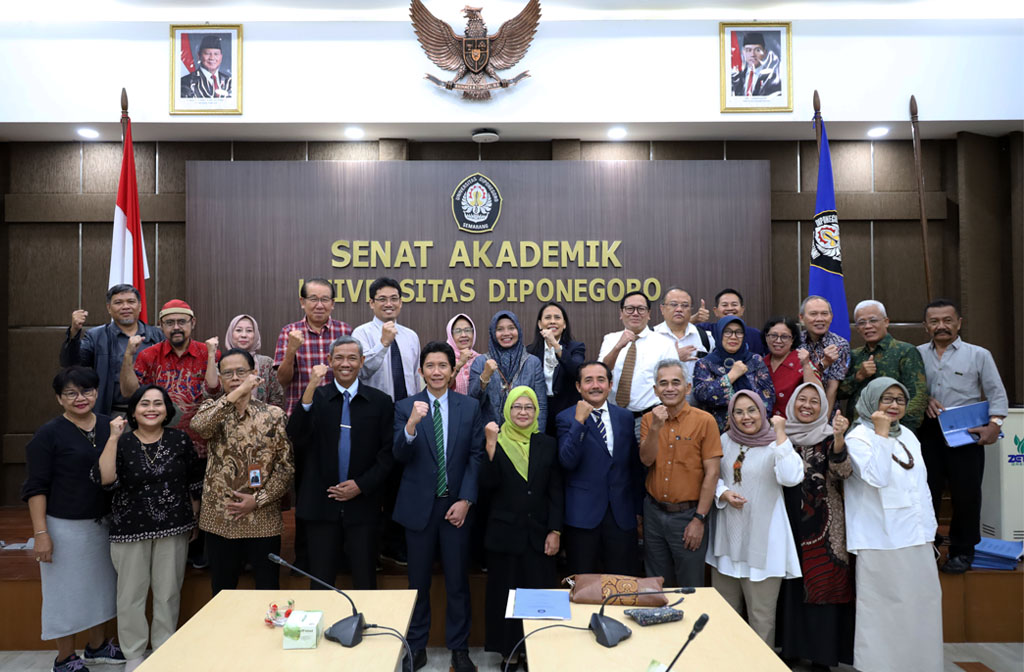UNDIP, Semarang (May 19, 2025) – Universitas Diponegoro (UNDIP) held scientific paper presentations for three professor candidates on Monday, May 19, 2025. The UNDIP’s Board of Professors organized the event, which took place in the Academic Senate Meeting Room on the 3rd floor of the SA-MWA Building, UNDIP Tembalang Campus.
The three candidates were Dr. dr. Yan Wisnu Prajoko, M.Kes., Sp.B., Subsp.Onk(K), from the Faculty of Medicine; Dr. Anis Muktiani, M.Si., from the Faculty of Animal and Agricultural Sciences; and Dr. Darsono, S.E., Akt., MBA, from the Faculty of Economics and Business.
In his presentation titled “A Multi-Aspect Review of Breast Cancer in Young Women,” dr. Yan Wisnu explained that although breast cancer in young women is relatively rare, it tends to be more aggressive. This occurrence contributes to poorer prognoses, higher recurrence rates, and increased mortality. However, early detection and appropriate treatment can significantly reduce these risks.
Treating breast cancer in young women poses its challenges. Surgical procedures and adjuvant therapies like chemotherapy and hormonal treatment often have side effects that require special attention for this age group.
Psychosocial aspects are also critical, including stress and anxiety, personal relationship disruptions, body image and sexuality changes, and fertility concerns. Limited access to healthcare services also influences clinical decisions and treatment choices.
Complementary and Alternative Medicine (CAM) has shown potential as an effective adjuvant cancer therapy. Yet, its implementation in standard medical practice remains limited. dr. Yan emphasized the need for greater understanding among healthcare professionals, stronger policy support, and further research to ensure the safety and effectiveness of these therapies.
Given the complexity of treating breast cancer in young women, a multidisciplinary management approach is ideal. This management team includes surgical oncologists, medical oncologists, radiologists, radiation oncologists, pathologists, clinical nurses, psychologists, psychiatrists, physiotherapists, and genetic specialists. A comprehensive team approach is expected to yield better outcomes for patients.
In another session, Dr. Anis Muktiani presented her paper titled “Improving Dairy Livestock Productivity and Health Through Supplementation Strategies.” She highlighted that domestic milk production currently meets only 17.7% of national demand. The majority—84.7%—is produced by smallholder farms facing challenges such as low yields, reproductive disorders, and suboptimal animal health. To address these issues, Dr. Anis proposed supplementation strategies involving the use of nutrients and additives to modulate metabolism and enhance immunity.
Minerals like Zinc (Zn), Chromium (Cr), and Selenium (Se) are particularly promising. Supplementing 49 mg/kg of Zn and 1.59 mg/kg of Cr in dry feed for dairy cows has been shown to boost milk yield and fat and lactose content and improve animal health. Similar results were observed in Peranakan Etawah dairy goats, with improvements in milk composition and feed conversion.
Oils can also serve as an energy source but may harm rumen microbes, which are needed for protection technology. A solution is to use protected fats such as Zn soap made from palm oil, which offers energy and additional minerals. In vitro tests of 5% palm oil-based Zn soap showed improved fiber digestibility and increased unsaturated fatty acids in rumen fluid.
Supplementation also benefits reproduction. A combination of soybean meal, Zn (30 mg/kg), Se (0.2 mg/kg), and vitamin E (400 mg/day) extended estrus duration and improved cervical mucus quality in lactating goats. Supplementing pregnant goats with Zn and folic acid increased litter size and birth weight. To combat mastitis, combining probiotics (S. cerevisiae and A. oryzae) with Zn, Cr, and Se reduced somatic cell counts in milk. A mixture of papaya leaf powder and turmeric with Se also reduced mastitis-related inflammation.
Dr. Anis offered specific dosage recommendations: 40–60 mg/kg dry feed of Zn for lactating dairy cows, 20–30 mg/kg for dairy goats, and 1.5–2 mg/kg of Cr for both. She emphasized that combining minerals with feed additives and using protected oil technologies like Zn soap enhances supplementation effectiveness. The use of oil protection technology in the form of Zn soap can prevent the negative impacts of oil supplementation.
In the final presentation, Dr. Darsono, S.E., Akt., MBA. delivered a paper titled “Audit as Part of the Three Lines Model in Supporting Sustainable Corporate Performance.” He emphasized that auditing practices must evolve with the changing business landscape and its reporting requirements. Modern businesses focus inward, outward, and forward, requiring reports that go beyond financials to include non-financial information and intangible assets that now play a key role in corporate valuation.
Using the balanced scorecard approach, reporting standards bodies have developed sustainability report formats that incorporate ESG (Environmental, Social, Governance) elements, along with integrated reports that illustrate corporate value creation. As a result, companies now issue financial reports, non-financial reports, sustainability reports, and integrated reports.
This evolution poses challenges for the auditing field. Auditing, once centered on financial statements, now includes evaluating the credibility of management reports. In Indonesia, public accountants, as auditors, can play a role in providing assurance services on information other than financial statements presented in Integrated Reporting using applicable audit standards. In addition, Public Accountants can also play a role in providing consultancy services on Integrated Reporting, such as implementation and socialization.
These changes also open research opportunities in audit. Dr. Darsono identified several areas for further exploration:
- Audit Quality: Traditionally measured through financial audits with established standards, audit quality must now encompass sustainability and integrated reports, which require new assessment approaches.
- Audit Lag: Currently, authorities require financial reports to be submitted within three months of the fiscal year’s end. With more complex and numerous reports, this timeline may need to be reevaluated, considering the capacity and competency of accounting firms and their auditors.
- Auditor Psychology: Studies show that psychological traits such as narcissism and stress levels can influence audit quality, especially with the increasing volume and variety of audit tasks.
- Audit Education: With the increasing development of audit aspects, whether there are sufficient teaching materials and learning methods for undergraduate students, participants in audit professional education, and auditors.
